INTRODUCTION
The holiday commenced on the 9th of October from Birmingham Airport, on First Choice flight FCA 259C at 08.05am. The Holiday was booked through Villa Select Ltd who arranged the accommodation, flights, and car hire. We were accompanied by our daughter, son-in-law and grandson.
Total cost of the holiday was £2378:90. This included staying 14 nights self catering at the 5* premier villa, Casa Dionisio.
Vehicle hire was 2 Ford Fiesta Ghia’s with 4 doors and aircon from Auto Jardim Rent-a-car.
Our intention was to visit Portugal during peak autumn migration.
FIELD GUIDES:-
Finding Birds in Southern Portugal published by Gostours ISBN 1 898110 18 2
A Birdwatching Guide to the Algarve by Kevin & Christine Carlson ISBN 1 900159 00 7
Additional up to date information was supplied by David & Amanda Mason www.realbirder.com
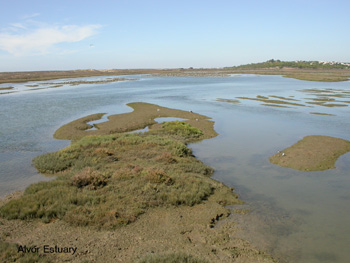 MAPS:-
MAPS:-
- Collins Algarve Holiday Map (revised edition)
- GeoCentre’s Leisure Map Algarve
- Michelin 940, 2002 Portugal & Madeira
Although we have birded in Portugal previously this was our first time on the Algarve . The Field Guides used were several years old and with the continued development of the Algarve we suspected that we would have problems finding our way around.
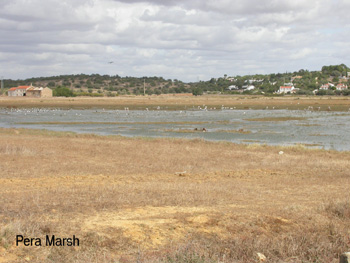 This could not have been further from the truth, whether it was luck we know not, but following the above guides we found all the sites first time with the exception of Pera Marsh, whose entrance was obscured by major road works. A feat we have never managed before.
This could not have been further from the truth, whether it was luck we know not, but following the above guides we found all the sites first time with the exception of Pera Marsh, whose entrance was obscured by major road works. A feat we have never managed before.
The weather in the main was dry and warm. Several storms did occur during our trip but these were restricted to a couple of evenings and had no effect on our birding. As the Algarve is situated on the Atlantic coast it came as no surprise that we had a constant breeze which varied in strength daily.
The trip was designed so that we would have family breakfasts where possible, returning late afternoon in order to spend some time with the family. This meant that the trip was far from a thrash, especially if the amount of time spent at Pera talking to other birders is taken into account. The total number of bird species seen was 123, easily obtainable by leisurely visiting the recognised birding sites.
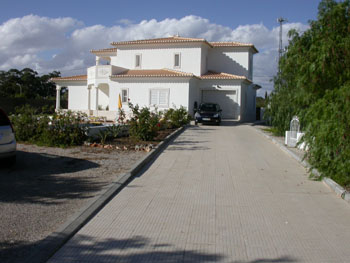 Villa Casa Dionisio was situated to the east of Albufeira at Olhos D’Agua and was within 1.5 hrs drive of all the recognised birding sites. I suppose it would be fair to say that the whole sprawl that is Albufeira is not a place we would rush to return too, although the rest of the family found the local beaches great and also utilised the variety of local restaurants and family orientated attractions.
Villa Casa Dionisio was situated to the east of Albufeira at Olhos D’Agua and was within 1.5 hrs drive of all the recognised birding sites. I suppose it would be fair to say that the whole sprawl that is Albufeira is not a place we would rush to return too, although the rest of the family found the local beaches great and also utilised the variety of local restaurants and family orientated attractions.
The villa had extensive grounds and was adjacent to citrus orchards and a smallholding, making it attractive to many of the local birds. Our garden list included Sardinian Warbler, Serin, Azure-winged Magpie, Waxbill, Crested Lark, Fan-tailed Warbler, Chiffchaff, Little Owl, Spotless Starling and Kestrel, as well as the normal garden species you would expect to find.
Our thanks go to many of the resident birders who were happy to furnish us with recent bird sighting information, security aspects and little known birding spots.
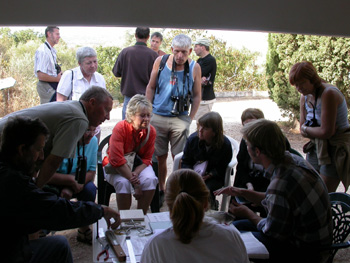 A special thanks to Dr Colin Key for his information on the construction of the golfing complex at Morgardo de Reguengo, where two new lakes have been created providing a habitat where a few rarities have recently occurred.
A special thanks to Dr Colin Key for his information on the construction of the golfing complex at Morgardo de Reguengo, where two new lakes have been created providing a habitat where a few rarities have recently occurred.
We would also like to thank all the staff at the A Rocha ringing station at Alvor for their very warm welcome, the free coffee and cake and the patience and thoroughness they showed when explaining all the environmental research work they undertake on and around the western Alvor marshes. Special thanks to Will & Rachel Simonson, Ruben Heleno and Isabel Soares.
This project is part funded through voluntary donation, so if you visit please donate. The centre is only open Thursdays from 10:00am . A comprehensive annual report into the eco-system of the Alvor marshes can be purchased.
BIRDING SITES VISITED
- Sunday 10th October Armacao de Pera Lagoon (found in error whilst looking for Pera Marsh), Pera Marsh.
- Monday 11th October Pera Marsh, Alvor Estuary
- Tuesday 12th October Cabo de Sao Vicente, Quinta dos Carricos (water treatment works), Pera Marsh
- Wednesday 13th October Quinta do Lago (West)
- Thursday 14th October Alvor (bird ringing centre & estuary), Monchique & Foia.
- Friday 15th October Quinta do Lago (East)
- Saturday 16th October Pera Marsh
- Sunday 17th October Birding free day, late breakfast and Sunday lunch with the family
- Monday 18th October Castro Verde
- Tuesday 19th October Vilamoura, Pera Marsh
- Wednesday 20th October Castro Marim
- Thursday 21st October Pera Marsh, Morgado de Reguengo
- Friday 22nd October Cabo de Sao Vicente
- Saturday 23rd October Return to U. K.
SITES VISITED NOT IN THE BIRD GUIDES
Armacao de Pera Lagoon
Can be found by approaching Armacao de Pera from Pera Marsh. Over the new roundabout to the T junction turn left. As you enter Armacao de Pera take first major left and left again where road bears left. At roundabout on the seafront turn left to the end & lagoon is on the left. (Good for Terns, Gulls & waterfowl)
Quinta dos Carricos Water treatment works
From Lagos heading west on N125, turn left towards Salema shortly after the town of Budens & water treatment works are 150 metres on the right. View the lagoons from around the perimeter fence. Our visit produced Green Sandpipers, Cattle Egrets, B.W. Stilts and various wagtails.
Morgardo de Reguengo Golf Complex
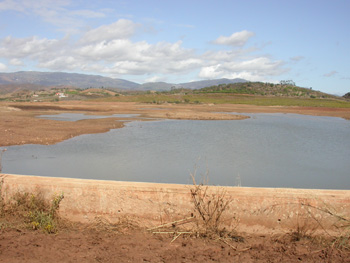 From Portimao take the N124 north, signed Monchique. Within a couple of kilometres of passing the motorway is a left turn signed Reguengo and a Golf sign. Follow the golf signs which will take you to a dam with a lake on your right. 200 metres on is the clubhouse, turn right here and follow this track which will bring you to a second lake. This was still filling when we visited. Our visit produced various ducks, 16 Spoonbills, 7 Flamingos, Cattle & Little Egret. Lunch at the Clubhouse was excellent and very good value; 1 club sandwich, 1 fillet of fish with all the trimmings, 1 pudding & 2 large coffees in large bone china cups all for the princely sum of 19 euros.
From Portimao take the N124 north, signed Monchique. Within a couple of kilometres of passing the motorway is a left turn signed Reguengo and a Golf sign. Follow the golf signs which will take you to a dam with a lake on your right. 200 metres on is the clubhouse, turn right here and follow this track which will bring you to a second lake. This was still filling when we visited. Our visit produced various ducks, 16 Spoonbills, 7 Flamingos, Cattle & Little Egret. Lunch at the Clubhouse was excellent and very good value; 1 club sandwich, 1 fillet of fish with all the trimmings, 1 pudding & 2 large coffees in large bone china cups all for the princely sum of 19 euros.
TRIP LIST
- Little Grebe Tachybaptus ruficolis Many birds were encountered at all suitable locations. Pera Marsh held 50>.
- Great Crested Grebe Podiceps cristatus 7 birds at the lagoon Quinta do Lago 15th, 1 Castro Marim 20th.
- Black-necked Grebe Podiceps nigricollis 2 sightings only, 1 at Quinta do Lago golf course 15th, 1 at Pera 9th.
- Gannet Morus bassanus Many immature birds seen all along the coast west of Alvor. Many adult birds heading east from Cabo de Sao Vicente.
- Cormorant Phalacrocorax carbo Birds common in small numbers at suitable locations.
- Squacco Heron Ardeola ralloides Up to 4 birds present at Pera Marsh during the duration of the trip.
- Cattle Egret Bubulcus ibis Birds very common all over the Algarve.
- Little Egret Egretta garzetta Status as above.
- Grey Heron Ardea cinerea The commonest of the herons with 20> always present at Pera.
- White Stork Ciconia ciconia Small numbers encountered daily.
- Spoonbill Platalea leucorodia Birds seen at Pera (9), Quinta do Lago (14), Castro Marim (15), Morgardo de Reguengo (16).
- Greater Flamingo Phoenicopterus ruber Flocks in excess of 200 at Pera Marsh, Quinta do Lago and Castro Marim.
- Widgeon Anas penelope Small numbers at several sites, 30> at Quinta do Lago golf course 13th.
- Gadwall Anas strepera Small numbers at all suitable locations.
- Teal Anas crecca Birds began to turn up during the second week. Nowhere was the bird common.
- Mallard Anas platyrhynchos Birds very common at all suitable sites.
- Pintail Anas acuta Same status as Teal.
- Shoveller Anas clypeata Rivalled Mallard for most common duck of the region.
- Red-crested Pochard Netta rufina One pair on the golf course lake at Quinta do Lago 15th.
- Pochard Aythya ferina Numbers began to climb second week, good numbers at Morgardo golf complex.
- Marsh Harrier Circus aeruginosus 1 female bird present at Pera Marsh most visits.
- Hen Harrier Circus cyaneus 2 sightings of a female at Cabo de Sao Vicente, possibly the same bird 22nd.
- Sparrowhawk Accipiter nisus Only 1 sighting of a female at Alvor ringing station 14th.
- Buzzard Buteo buteo 3 sightings at Castro Verde 18th.
- Booted Eagle Hieraaetus pennatus 6 birds flying south west Cabo de Sao Vicente 12th.
- Red-legged Partridge Alectoris rufa Birds extremely common around Castro Verde with flocks of 50> not uncommon.
- Moorhen Gallinula chloropus Birds common at all suitable locations.
- Purple Gallinule Porphyrio porphyrio Double figure numbers at Pera Marsh, 4 birds present at Quinta do Lago golf course.
- Coot Fulica atra Extremely common at all suitable locations. 1000> birds on the lake as you enter Vila Real de Santo Antonio.
- Little Bustard Tetrax tetrax 30> birds present on the fields adjacent to the salt works Castro Marim 20th.
- Great Bustard Otis tarda 4 birds were encountered during our trip to Castro Verde; 2 fly-bys and 2 near Mertola.
- Oystercatcher Haematopus ostralegus Several dozen birds loafing with the gulls Alvor estuary.
- Black-winged Stilt Himantopus himantopus Birds common at suitable locations with 50> at Pera.
- Avocet Recurvirostra avosetta Similar status as Black-winged Stilts.
- Stone Curlew Burhinus oedicnemus Several sightings between Castro Verde and Mertola with one flock 20> strong.
- Ringed Plover Charadrius hiaticula A very common wader with birds at all sites visited.
- Kentish Plover Charadrius alexandrinus More common than Ringed Plover.
- Golden Plover Pluvialis apricaria 10> birds seen at Pera Marsh most visits.
- Grey Plover Pluvialis squatarola Birds encountered at all estuarine sites.
- Lapwing Vanellus vanellus Small numbers encountered at several sites, 6-8 birds ever present at Pera Marsh.
- Knot Calidris canutus Birds only encountered at the Alvor estuary where a small flock of a dozen or so was present.
- Sanderling Calidris alba Very common both on the coast and inland waters.
- Little Stint Calidris minuta Small numbers at most sites with good numbers at Castro Marim.
- Temminck’s Stint Calidris temminckii 3 birds at Alvor 11th, 2 at Quinta do Lago 15th, with 20> at Castro Marim 20th.
- Curlew Sandpiper Calidris ferruginea Surprising numbers with good numbers seen at all suitable locations.
- Dunlin Calidris alpina Small numbers encountered at suitable locations.
- Ruff Philomachus pugnax Only sighting was 4 birds at the Pera Marsh on the 11th.
- Snipe Gallinago gallinago A common wader of the area with many at Pera Marsh every visit.
- Black-tailed Godwit Limosa limosa Possibly the commonest wader of the area.
- Bar-tailed Godwit Limosa lapponica 1 sighting only, a single bird with Black-tailed Godwits at Quinta do Lago.
- Whimbrel Numenius phaeopus Only sighting was several birds at Quinta do Lago.
- Curlew Numenius arquata Surprisingly few sightings with a few birds at Quinta do Lago.
- Spotted Redshank Tringa erythopus Only sighting was 2 birds at Castro Marim 20th.
- Redshank Tringa totanus Fair numbers at suitable sites but not as common as expected.
- Greenshank Tringa nebularia Singletons seen at most sites but not as common as expected.
- Green Sandpiper Tringa ochropus Only sightings were 2 birds at Quinta dos Carricos water treatment works and 1 at Castro Verde.
- Common Sandpiper Actitis hypoleucos A very common wader of the area.
- Turnstone Arenaria interpres Small numbers at most coastal sites.
- Mediterranean Gull Larus melanocephalus Odd birds with other gulls, all sightings were at Pera Marsh.
- Black-headed Gull Larus ridibundus Probably the most common gull of the region.
- Slender-billed Gull Larus genei 2 birds at Castro Marim salt works 20th.
- Audouin’s Gull Larus audouinii An adult bird at Alvor estuary 11th.
- Common Gull Larus canus2 birds on sandbar with Y-L Gulls at Alvor 11th.
- Yellow-legged Gull Larus cachinnans Extremely common.
- Caspian Tern Sterna caspia Possibly the same bird seen on 3 occasions at Pera Marsh and Armacao de Pera lagoon.
- Sandwich Tern Sterna sandvicensis Odd birds at Pera, Alvor and Castro Marim.
- Common Tern Sterna hirundo 1 fly-by at Alvor 11th.
- Black Tern Chlidonias niger 4 birds at Pera Marsh 16th reduced to 2 by 19th with 1 bird remaining for the remainder of our trip.
- Rock Dove Columba livia Half a dozen birds on the rocks at Cabo de Sao Vicente.
- Stock Dove Columba oenas A small flock feeding in the fields adjacent to Castro Marim salt works 20th.
- Wood Pigeon Columba palumbus Not common, with small numbers seen mostly inland.
- Collared Dove Streptopelia decaocto Common at all suitable locations.
- Little Owl Anthene noctua 3 sightings, 2 single birds at Cabo de Sao Vicente and a pair on the track to Pera Marsh.
- Alpine Swift Apus melba One of the highlights of the trip, with hundreds of birds hawking low over the fields at the back of Pera Marsh 10th.
- Kingfisher Alcedo atthis Obvious winter influx with birds at most suitable sites.
- Hoopoe Upupa epops Not common, main sightings were a pair that visited the Villa most days.
- Great-spotted Woodpecker Dendrocopos major 1 bird seen en-route to Monchique.
- Crested Lark Galerida cristata Very common over the Algarve .
- Thekla Lark Galerida theklae I was reliably informed by local birders that the majority of the larks encountered at Cabo de Sao Vicente were Thekla.
- Crag Martin Ptyonoprogne rupestris Small flock at the fortified restaurant at Cabo de Sao Vicente.
- Swallow Hirundo rustica Very few sightings with a few birds a Cabo de Sao Vicente and half a dozen over the fort at Castro Marim.
- Meadow Pipit Anthus pratensis Good Autumn passage with many birds at suitable locations. Numbers increased during second week.
- Yellow Wagtail Motacilla iberiae A few sightings at various sites. 2 birds feasting on emerging flying ants at Pera golf course.
- Grey Wagtail Motacilla cinerea The commonest of the wagtails.
- White Wagtail Motacilla alba Birds common on inland waters.
- Robin Erithacus rubecula Obvious influx of winter birds during the second week.
- Bluethroat Luscinia svecica 4 sightings all at Quinta do Lago.
- Black Redstart Phoenicurus ochruros Only sightings were 4 birds at the lighthouse at Cabo de Sao Vicente on our last day 22nd.
- Redstart Phoenicurus phoenicurus Only 1 sighting, a single bird in the bushes at the trig point at the Cabo de Sao Vicente.
- Whinchat Saxicola rubetra Sightings restricted to 1 bird Cabo de Sao Vicente on 12th and a singleton at Quinta do Lago on 13th.
- Stonechat Saxicola torquata The ubiquitous Stonechat; if a bird is on the top of a bush and doesn’t fly as soon as you start to focus on it, it’s a Stonechat.
- Northern Wheatear Oenanthe oenanthe Very common, with birds seen almost everywhere.
- Blue Rock Thrush Monticola solitarius Single sighting confined to the last day at Cabo de Sao Vicente.
- Blackbird Turdus merula Alarm calls became more apparent during the second week as birds established winter territories.
- Mistle Thrush Turdus viscivorus Odd birds could be found especially on the manicured fairways of the numerous golf courses.
- Cetti’s Warbler Cettia cetti Remarkably few sightings, 1 bird seen & heard at Quinta do Lago golf course lake and 1 from a river bridge on the road to Mertola.
- Fan-tailed Warbler Cisticola juncidis Very common almost everywhere. Pera Marsh has the largest population per square metre that we have encountered anywhere.
- Dartford Warbler Sylvia undata A couple of sightings at the Cabo de Sao Vicente trig point 12th.
- Sardinian Warbler Sylvia melanocephala Far fewer sightings than we expected, odd birds seen daily. Resident pair in the garden.
- Garden Warbler Sylvia borin Only sighting was a bird caught in the mist nets at the Alvor ringing station.
- Blackcap Sylvia atricapilla 1 male at Cabo de Sao Vicente 12th & 2 females in the mist nets Alvor ringing station.
- Chiffchaff Phylloscopus collybita Birds abundant in the region with several birds daily in the garden.
- Willow Warbler Phylloscopus trochilus Sightings restricted to the Cape and around Castro Verde.
- Spotted Flycatcher Muscicapa striata Odd birds seen during the trip with 5 birds around the lighthouse at Cabo de Sao Vicente 22nd.
- Blue Tit Parus caeruleus Not a common bird, most sightings at elevated sites with large stands of Pine.
- Great Tit Parus major Far more common than the former with birds seen daily in and around the villa grounds.
- Great Grey Shrike Lanius excubitor A common bird of the Alentejo with birds at almost every turn.
- Jay Garrulus glandarius Odd sightings of this bird; first couple of sightings were well inland then towards the 2nd week they began to appear nearer the coast, increasing speculation of a winter influx.
- Azure-winged Magpie Cyanopica cyanus A bird synonymous with Portugal . Flocks of 20> not uncommon around the villa.
- Chough Pyrrhocorax pyrrhocorax Birds only encountered at the Cape with a flock of 100> seen on the back road to Vila do Bispo.
- Jackdaw Corvus monedula Only sightings were a flock around the lighthouse and another half dozen birds by the farm on the track to Vila do Bispo.
- Carrion Crow Corvus corone A small number of sightings usually of flocks of 4-6.
- Spotless Starling Sturnus unicolor Birds common especially inland, flocks seen regularly around the villa.
- House Sparrow Passer domesticus A very common bird at all locations.
- Common Waxbill Estrida astrild A flock 30> most mornings on the villa lawn especially after the automatic sprinklers had been on. Very common.
- Chaffinch Fringilla coelebs Only sighting was a female caught in the mist nets at the Alvor ringing station.
- Serin Serinus serinus Small numbers seen especially in the villa garden where 3-4 birds were ever present.
- Greenfinch Carduelis chloris The 2nd commonest finch of the region, birds seen most days.
- Goldfinch Carduelis carduelis By far the most common finch of the region.
- Siskin Carduelis spinus Only sighting was a singleton at the villa although birds were heard in the pines at Vilamoura.
- Linnet Carduelis cannabina Small number Pera Marsh 10th.
- Corn Bunting Miliaria calandra Only birds encountered were between Castro Verde and Mertola when flocks in excess of 20 were not uncommon.
Notes
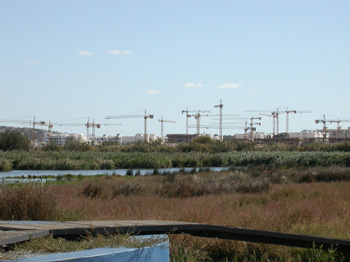
As previously stated we had intended to be in the Algarve during the height of the migration. We are aware that autumn migration is far more difficult to predict than spring, so we looked through birding reports to determine the optimum time.
As it happened the weather in northern Portugal and Southern France was so bad that it was probably affecting migration. Many opinions were given from “the birds were being held up in the Pyrenees” to “the birds were not stopping and going straight through Portugal.” In reality nobody knew; it was just one of those years, with raptor passage in particular being very disappointing.
Over-wintering Cranes at Pera Marsh
Pat and Judy Hayes
